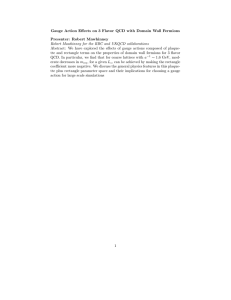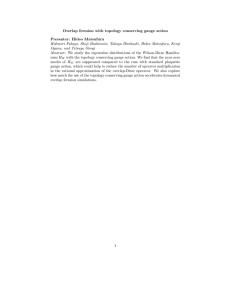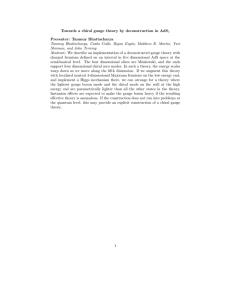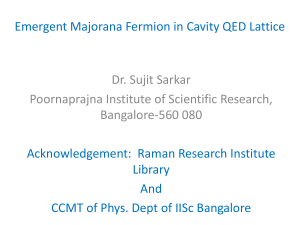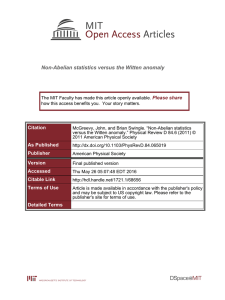Non-Abelian Statistics The Witten Anomaly versus in
advertisement
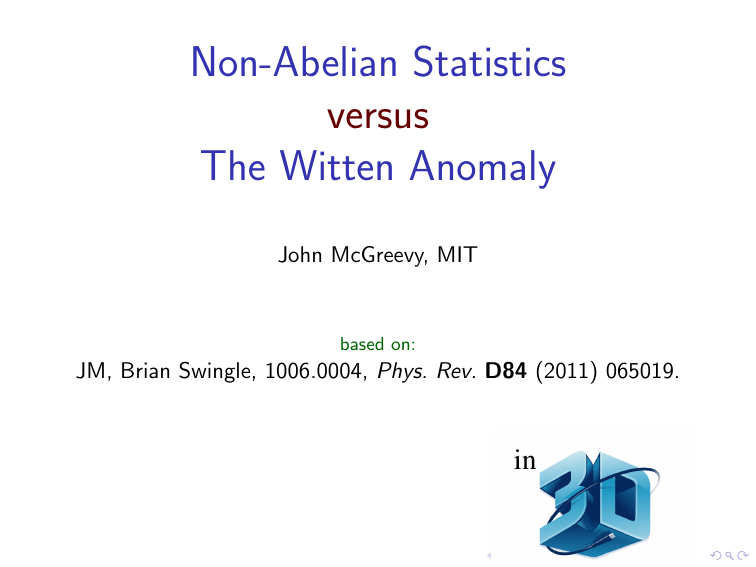
Non-Abelian Statistics
versus
The Witten Anomaly
John McGreevy, MIT
based on:
JM, Brian Swingle, 1006.0004, Phys. Rev. D84 (2011) 065019.
in
Interactions between hep-th and cond-mat have been very fruitful:
SSB, higgs mechanism, topological solitons ...
More recently: hopes for many practical uses for string theory.
e.g. controllable examples of non-Fermi liquid fixed points
(possible states of fermions at finite density other than Landau’s nearly free
effective field theory).
QFT question for today: Is it possible to realize deconfined
particles in 3+1 dimensions which exhibit non-abelian statistics?
There’s a recent set of ideas, inspired by work in cond-mat,
suggesting a route to doing this seemingly-impossible thing.
Its failure mode is interesting.
Particle statistics
In 3+1 dims particles are either bosons or fermions.
Why: boring topology of configuration space:
π0 (paths) = π1 (Cn3+1 ) = Sn
Cnd+1 ≡ {config space of n particles}\{close approaches}
In 2+1: π1 (Cn2+1 ) = Bn , braid group (infinite-dimensional) → anyons.
Particle statistics
In 3+1 dims particles are either bosons or fermions.
Why: boring topology of configuration space:
π0 (paths) = π1 (Cn3+1 ) = Sn
Cnd+1 ≡ {config space of n particles}\{close approaches}
In 2+1: π1 (Cn2+1 ) = Bn , braid group (infinite-dimensional) → anyons.
Figure: Onion braid diagram
from [gypsymagicspells.blogspot.com]
Anyons
Abelian anyons: state of several anyons acquires a phase upon braiding.
Non-Abelian anyons: braiding acts by a unitary on degenerate statespace.
Abelian anyons exist and have been observed as quasiparticles in
well-understood FQHE states.
∃ good evidence that non-Abelian anyons are also realized in FQHE states.
Non-Abelian anyons would make
a great quantum computer [Kitaev, Freedman]
• Quantum state stored non-locally
protected from decoherence to (local) environment.
• Do computations
by adiabatically braiding anyons.
[Hasan-Kane]
Majorana solitons
A framework for realizing a class of non-abelian anyons:
Majorana zeromode localized on soliton
γi = γi†
{γi , γj } = 2δij
i, j = 1..n
Hilbert space of groundstates of n solitons represents this algebra.
Γ1 ≡ γ 1 + iγ 2 , ...
Γ1 | ↓↓i ≡ 0, Γ†1 | ↓↓i = | ↑↓i...
n such ‘Ising anyons’ make a degenerate space of dimHn ∼
√
n
2 .
info about Hn not localized on particles (despite realization in local QFT).
Realizations in 2 + 1d:
ν=
5
2
QH states
[Moore-Read, Nayak-Wilczek],
surface states of TI
[Fu-Kane],
p + ip superconductors
solvable toy models
[Kitaev],
[Ivanov, Read-Green],
many other proposals.
Majorana solitons, an example in 2+1 d
Fermionic quasiparticles in certain 2d superconductors:
c↑
c↓
χ ≡ † Lfermions = iχT σ i ∂i + ΦΓ+ + Φ̄Γ− χ
c↑
c↓†
0.5
Vortex: Φ(r , ϕ) = e iϕ |Φ(r )|
Χ
0.4
[Jackiw-Rossi, Ivanov, Read-Green]
0.3
has a majorana zeromode.
0.2
ÈFÈ
0.1
Note: Ising anyons are a special case
r
2
4
6
8
(not universal for quantum computation).
Lesson: All we need to do to realize non-Abelian (Ising) statistics
is to find solitons with normalizable majorana zeromodes.
Majorana hedgehogs
Consider a 3+1d system with a global SO(3) symmetry
broken by an adjoint scalar vev
hΦA ΦA i = v 2
A = 1, 2, 3.
Couple to a real 8-component spinor
(two majorana doublets of SU(2) ' SO(3)):
Hfermions = iχT γ i ∂i + λΦA ΓA χ
hΦi gaps fermions, mbulk ∼ λv .
Majorana hedgehogs
Consider a 3+1d system with a global SO(3) symmetry
broken by an adjoint scalar vev
hΦA ΦA i = v 2
A = 1, 2, 3.
Couple to a real 8-component spinor
(two majorana doublets of SU(2) ' SO(3)):
Hfermions = iχT γ i ∂i + λΦA ΓA χ
hΦi gaps fermions, mbulk ∼ λv .
r →∞
Hedgehog: ΦA = r̂ A φ(r )
φ(r ) ∼ v ,
has a majorana zeromode.
r →0
φ(r ) → 0
Majorana hedgehogs
Consider a 3+1d system with a global SO(3) symmetry
broken by an adjoint scalar vev
hΦA ΦA i = v 2
A = 1, 2, 3.
Couple to a real 8-component spinor
(two majorana doublets of SU(2) ' SO(3)):
Hfermions = iχT γ i ∂i + λΦA ΓA χ
hΦi gaps fermions, mbulk ∼ λv .
r →∞
Hedgehog: ΦA = r̂ A φ(r )
φ(r ) ∼ v ,
has a majorana zeromode.
r →0
φ(r ) → 0
Aside on motivation from topological insulators with
superconductors attached: [Fu-Kane 08, Teo-Kane 09, Wilczek, unpublished]
Φ1 + iΦ2 = supercond. order parameter (zero at vortex)
Φ3 = Dirac mass (changes sign at bdy of TI)
m>0
m<0
Problems of majorana hedgehogs
The hedgehogs are not quite particles: spatial var. of Φ is extra data.
Minimal data for topology:
preimage under Φ of north pole and nearby point
−→ ribbon between hedgehog pairs.
[Freedman et al, 1005.0583]
“projective ribbon statistics”
Φ
Φ
Problems of majorana hedgehogs
The hedgehogs are not quite particles: spatial var. of Φ is extra data.
Minimal data for topology:
preimage under Φ of north pole and nearby point
−→ ribbon between hedgehog pairs.
Φ
[Freedman et al, 1005.0583]
“projective ribbon statistics”
Observation: Variation of Φ costs energy.
Hedgehogs are not finite-energy excitations
Z L
~ A · ∇Φ
~ A + ... ∼ v 2 L
E = H[Φhedgehog ] ∼
d 3 x ∇Φ
0
(like global SO(2) vortex in 2+1 dims).
Configurations with zero total hedgehog number have finite energy
2
RR
But: Veff (R) ∼ 0 r 2 dr · φr
∼ Rv 2 .
linear confinement.
R
Not so good for adiabatic motion.
Φ
Deconfined majorana solitons in 3 + 1 dims?
Two apparently-different routes to models with
deconfined majorana particles:
I
Gauge the SU(2) symmetry
I
Disorder the hΦi. (Zero stiffness, no gradient energy.)
Gauge the SU(2)
•
•
hΦi∈adj
SU(2) → U(1)
Sol’n with ΦA = r̂ A φ(r ) → ‘t Hooft-Polyakov monopole:
j
A
AA
i = ijA r̂ A(r ), A0 = 0
1
r →∞
=⇒ Di Φ → 0.
r
• carries magnetic charge = hedgehog #
0
=⇒ magnetic coulomb force F ∼ qmr 2qm (falls off!)
r →∞
φ(r ) ∼ v ,
r →∞
A(r ) ∼
Gauge the SU(2)
•
•
hΦi∈adj
SU(2) → U(1)
Sol’n with ΦA = r̂ A φ(r ) → ‘t Hooft-Polyakov monopole:
j
A
AA
i = ijA r̂ A(r ), A0 = 0
1
r →∞
=⇒ Di Φ → 0.
r
• carries magnetic charge = hedgehog #
0
=⇒ magnetic coulomb force F ∼ qmr 2qm (falls off!)
r →∞
φ(r ) ∼ v ,
•
r →∞
A(r ) ∼
1
~ + h.c.
Lfermions = χ† i σ̄ µ Dµ χ − λχ∨~τ · Φχ
2
χαa Weyl ∈ (1, 2, 2) of SU(2)L × SU(2)R × SU(2)gauge
χ∨ ≡ χT iσ 2 iτ 2 ∈ (1, 2̄, 2̄)
• Two independent mass scales:
mW = gv , and the mass of the fermion λv .
Gauge the SU(2)
•
•
hΦi∈adj
SU(2) → U(1)
Sol’n with ΦA = r̂ A φ(r ) → ‘t Hooft-Polyakov monopole:
j
A
AA
i = ijA r̂ A(r ), A0 = 0
1
r →∞
=⇒ Di Φ → 0.
r
• carries magnetic charge = hedgehog #
0
=⇒ magnetic coulomb force F ∼ qmr 2qm (falls off!)
r →∞
φ(r ) ∼ v ,
•
r →∞
A(r ) ∼
1
~ + h.c.
Lfermions = χ† i σ̄ µ Dµ χ − λχ∨~τ · Φχ
2
χαa Weyl ∈ (1, 2, 2) of SU(2)L × SU(2)R × SU(2)gauge
χ∨ ≡ χT iσ 2 iτ 2 ∈ (1, 2̄, 2̄)
• Two independent mass scales:
mW = gv , and the mass of the fermion λv .
[ • Does not exist: Witten anomaly [Witten 1982] ]
Majorana zeromode
Momentarily treat A, Φ as classical background fields:
Dirac equation
0 = δχ̄ Sfermion = −i σ̄ µ Dµ χ + λ† iσ 2 Φ · τ iτ 2 χ? .
ansatz from [Jackiw-Rebbi, 1976], with reality conditions
χαa =
.
2 g (r ) (α: spin index, a: SU(2) doublet index).
iταa
(∂i + 2r̂i A)g + iλφr̂i g ? = 0.
rephasing χ =⇒ λ > 0 WLOG
g (r ) = ce −πi/4 e −
Rr
(λφ−2A)
3.5
3.0
c is a real constant.
solution determined by normalizability at r → ∞.
2.0
hHrL
phase of the normalizable
2.5
1.5
1.0
0.5
0.0
5
10
15
r
20
25
30
Witten anomaly
Z
[Dχ]e iSfermions [χ,A,Φ] ≡ e iΓ[A,Φ] × non-universal stuff
Fermion determinant represents π4 (SU(2)) = ZZ2 :
(?)
e iΓ[A
g ,Φg ]
= (−1)[g ] e iΓ[A,Φ] .
But A, Ag are continuously connected:
Z
=⇒
[DADΦ]e iΓ[A,Φ] × (anything gauge invariant) = 0
One argument for (?): Embed the theory in an SU(3) gauge
theory with a perturbative gauge anomaly
[Witten:1983,Elitzur:1984,Klinkhamer:1990].
Calculate the variation of the fermion measure between 1 and g by
integrating the SU(3) anomaly.
Claim: The addition of the adjoint scalar Φ doesn’t change this.
Witten anomaly with adjoint scalar
More explicitly: consider the (perturbatively anomalous) SU(3) gauge
theory with
• an adjoint scalar Φ̃,
• an SU(3) triplet of Weyl fermions χ̃
• an SU(3) triplet of scalars Υ,
with the coupling
2
LSU(3) ⊃ χ̃T
a iσ Υb abc Φ̃cd χ̃d ,
a = 1, 2, 3 is a triplet index.
hΥi = λ breaks the SU(3) down to SU(2), is the Yukawa coupling.
The form of the perturbative SU(3) anomaly is unaffected by the addition of
scalars.
Γ[A, Φ] is a smooth functional for invertible Φ
(integrate out massive fermions)
Ineffable: naive ΓWZW [A, Φ] = 0 for SU(2).
Canceling the Witten anomaly
S[χ, Φ, A] → S[χ, Φ, A] + Γ[Φ, A]
But: if Φ = 0 anywhere, Γ is ill-defined. (e.g. core of monopole.)
Requires UV completion.
Important point: presence of fermion zms is a UV sensitive question.
L2
fermions
~ J − mIJ χ∨ χJ + h.c.
= χI † i σ̄ µ Dµ χI − λIJ χ∨
τ · Φχ
I ~
I
χI αa a pair of (left-handed) Weyl doublets of SU(2):
I = 1, 2 a flavor index, α = 1, 2: spin, a = 1, 2 gauge. 23 complex fermions
Same spectrum as
[Jackiw-Rebbi 76]
but more general couplings.
Three mass scales:
the mass of the W -bosons, mW = gv ,
and the masses of the two Weyl fermions λ1,2 v
E
λ 2v
gv
For λ1 v mW λ2 v
λ 1v
large window of energies with same bulk spectrum as above.
Relation to Jackiw-Rebbi model
λ is symmetric, λIJ = λJI by Fermi statistics.
By field redefinitions, can diagonalize λ with real eigenvalues λ1,2 .
Phase of m is physical.
m = m† , preserves a CP symmetry χ 7→ iσ 2 iτ 2 χ? .
Relation to Jackiw-Rebbi model
λ is symmetric, λIJ = λJI by Fermi statistics.
By field redefinitions, can diagonalize λ with real eigenvalues λ1,2 .
Phase of m is physical.
m = m† , preserves a CP symmetry χ 7→ iσ 2 iτ 2 χ? .
Jackiw-Rebbi case: λ1 = λ2 ≡ λ0 =⇒ extra U(1) symmetry:
0 λ0
iθ
−iθ
χ1 7→ e χ1 , χ2 7→ e χ2 (in basis where λ = λ 0 )
0
χ1
I
Ψ≡
. λ0 ≡ λ R
0 + iλ0
χ?2 iτ 2 iσ 2
I 5
~ + mΨ̄Ψ.
γ
~τ · ΦΨ
L2fermions = Ψ̄i DΨ
/ − Ψ̄ λR
+
iλ
0
0
For m = 0, JR found in this model a complex zeromode of the
monopole.
Quantizing this mode makes the monopole into a pair of bosons of
charge ±e/2 (under the ‘extra’ U(1)).
Fermion zeromodes in the two-doublet model
For mDirac = 0:
In the basis where λ is diagonal with real evals λ1,2 , zeromode equations for
χ1,2 decouple.
Two real solutions, like JR:
2
χI αa (r ) = iταa
gI ,
gI = cI e −πi/4 e −
Rr
(λI φ−2A)
For mDirac 6= 0:
Ansatz which decomposes χ ∈ (2, 2) into irreps of the unbroken
SU(2) ⊂ SU(2)gauge × SU(2)spin :
2
gI + i τ 2 τ i
χaαI = iτaα
gi.
aα I
Guess: ~g = r̂ gr (r ). Dirac equation becomes:
~ − 2ir̂ Ag − λ† g ? φr̂ − m†~g ?
0 = i ∇g
~ · ~g + 2iA~g · r̂ + λ†~g ? · r̂ φ + m† g ? .
0 = i∇
.
Conclusions about zeromodes
†
• First
√ assume m = m .
For λ1 λ2 v < m, both modes are non-normalizable.
(Else, both normalizable.)
Check: det Mbulk = λ1 λ2 v 2 − m2
2
→ 0 precisely at marginal normalizibility.
Sizes of zms can be varied independently by λ1,2 .
The zeromode wavefunctions involve products of exponentials of
the form e mr e −λvr , one might have thought (pantingly) that one
zeromode would become non-normalizable, e.g. for
λ1 v < m < λ2 v .
3.5
This hope is not realized.
3.0
Remnant: sometimes zm profile is ring-like: −→
2.5
hHrL
2.0
1.5
1.0
0.5
• For m 6= m† no zero-energy solutions.
0.0
5
10
15
r
20
25
No-go arguments
1. If we gauge away or disorder the Station Q ribbon, the
configuration space has π1 (Cn ) = Sn .
2. Rough sketch of argument for inevitability of Witten anomaly:
Witten
anomaly
majorana number
of monopole
chiral anomaly
mod two
axial
3
In a Witten-anomalous theory, (−1)F = e iπj0 = e iπτ is a gauge
symmetry. [Goldstone, 83]
=⇒ chiral anomaly mod two is a gauge anomaly.
(In a normal theory: ψL → ψ̄R .
Here: ψL →vacuum.)
?
I
indIR D[monopole]
/
=
~ · ~j axial
∇
2
S∞
[Callias 78]
: indC D
/
: real index for vortex in 2d
[Santos-Nishida-Chamon-Mudry, 09]
5d model
Some theories are only realizable as the boundary of a
higher-dimensional model. [Nielsen-Ninomiya, Kaplan]
e.g.: domain-wall fermions in lattice QCD,
single dirac cones on surface of a topological insulator
Consider SU(2) gauge theory in 4+1 dimensions
with a Dirac fermion doublet and adjoint Higgs.
On a circle: fourth spatial dimension y ' y + 2πR.
MHyL
Kink of M(r )
supports a 4d massless Weyl fermion.
Bad features: 5d; needs UV
completion (lattice, strings); kinks can annihilate.
Mass scales: MW , R −1 , the Dirac mass m,
the inverse thickness of the kink, extreme UV cutoff
At energies E 1/R, this model reduces to the two-doublet theory above.
y
Majorana monopole strings
q ∈ π2 (S 2 ) supports monopole strings.
(3d particles when stretched along y ).
Intersections between monopole strings
and domain walls of 5d mass
→ localized Majorana zeromodes.
• the two Majorana modes need not pair up.
For m R −1 , their
wavefunction overlap is exponentially small.
• low-energy
braiding always exchanges majoranas in pairs
• dyon rotor → 1+1 XY model along string.
decoherence to local basis or linear
confinement from monopole string tension:
space
M>0
M<0
y
space
M>0
M<0
y
Disordering the SU(2)
Imagine a state with hedgehogs but zero stiffness (no LRO).
Effective field theories for such states are usefully studied using
“slave particle” techniques
(successful in similar problem of spin liquid states).
Result: emergent U(1) gauge theory, under which the defects are
magnetically charged.
Again requires UV completion.
One way to do it: SU(2) gauge theory with a Weyl doublet.
Another attempt
[Freedman, Hastings, Nayak, Qi, 1107.2731]
: a lattice model
(majorana fermions with hopping amplitudes determined by a quantum dimer
model configuration)
They argue for a majorana zeromode on the defect.
But: gapless bulk fermions.
Reduces to two-doublet model with m = 0, λ1 6= 0, λ2 = 0!
Other possible loopholes?
I
What if we just gauge the U(1) ⊂ SU(2)?
Still linear tension.
I
What if the 5th dimension ends?
For some boundary conditions: gapless 4d mode
I
Lorentz-breaking fermion kinetic terms
Still anomalous?
[Tong]
?
[Station Q]
.
Other possible loopholes?
I
What if we just gauge the U(1) ⊂ SU(2)?
Still linear tension.
I
What if the 5th dimension ends?
For some boundary conditions: gapless 4d mode
I
Lorentz-breaking fermion kinetic terms
Still anomalous?
[Tong]
[Station Q]
.
?
Conclusion: It would be nice to tighten the no-go statement
(prove the CalliasIR index theorem, understand the functional Γ)
and it will be interesting to see what other physics has to come in
to save the world from non-Abelian statistics in 3+1 dimensions.
Final positive comment: These issues are important for
understanding possible generalizations of the notion of flux
attachment from 2+1 to 3+1.
The end
Thanks for listening.

